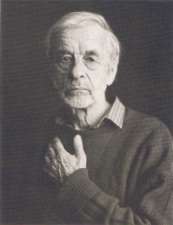Rudy Burckhardt
| Rudy Burckhardt | |
|---|---|
 | |
| Born |
April 6, 1914 Basel |
| Died |
August 1, 1999 (aged 85) Searsmont |
| Nationality | Swiss |
| Citizenship | American |
| Occupation | filmmaker |
Rudy Burckhardt (April 6, 1914, Basel – August 1, 1999, Searsmont) was a Swiss-American filmmaker, and photographer, known for his photographs of hand-painted billboards which began to dominate the American landscape in the nineteen-forties and fifties.[1][2][3]
Life
Burckhardt discovered photography as a medical student in London. He left medicine to pursue photography in the 1930s. He immigrated to New York City in 1935.[4] Between 1934 and 1939, he traveled to Paris, New York and Haiti making photographs mostly of city streets and experimenting with short 16mm films. While stationed in Trinidad in the Signal Corps from 1941-1944, he filmed the island's residents. In 1947, he joined the Photo League in New York City. Burckhardt married painter Yvonne Jacquette whom he collaborated with throughout their 40-year marriage. During the mid-Fifties he worked with Joseph Cornell on "The Aviary", "Nymphlight", "A Fable For Fountains", and "What Mozart Saw On Mulberry Street".[5] He taught filmmaking and painting at the University of Pennsylvania from 1967 to 1975. He is the great-uncle of author Andreas Burckhardt.
On his 85th birthday, Burckhardt committed suicide by drowning in the lake on his property.[6][7]
Recent exhibitions (selection)
- October 25, 2014 - February 15, 2015 "Rudy Burckhardt – In the Jungle of the Big City" at Fotostiftung Schweiz[8]
- November 4, 2011 - March 25, 2012 "The Radical Camera: New York's Photo League, 1936-1951" at Jewish Museum (New York)
- September 23, 2008 – January 4, 2009 "New York, N. Why? Photographs by Rudy Burckhardt, 1937–1940" at Metropolitan Museum of Art
- May 9 – July 15, 2000 "Rudy Burckhardt and Friends: New York Artists of the 1950s and '60s" at New York University
References
- ↑ http://www.nyss.org/exhibitions/rudy-burckhardt-maine/
- ↑ Glueck, Grace (May 30, 2003). "ART IN REVIEW; Rudy Burckhardt". The New York Times.
- ↑ Francis, Mark, ed. (2005). Pop. London: Phaidon Press Limited. p. 45.
- ↑ http://www.vincentkatz.com/criticism.htm
- ↑ http://www.independent.co.uk/arts-entertainment/obituary-rudy-burckhardt-1112344.html
- ↑ http://www.artnet.com/Magazine/reviews/oisteanu/oisteanu8-24-04.asp
- ↑ Smith, Roberta (August 4, 1999). "Rudy Burckhardt, 85, Photographer and Filmmaker, Dies". The New York Times. Retrieved October 29, 2014.
- ↑ Fotostiftung Schweiz
External links
- "The Cinema of Looking", Jacket 21
- http://topics.nytimes.com/topics/reference/timestopics/people/b/rudy_burckhardt/index.html
- http://www.film-makerscoop.com/search/search.php?author=Rudolph+Burckhardt
- http://www.milkmag.org/burckhardt%20page.htm
- http://www.moma.org/interactives/exhibitions/2002/burckhardt/
- http://www.tibordenagy.com/artists/rudy-burckhardt/Burckhardt, Rudy
- "Burckhardt, Rudy". SIKART dictionary and database.